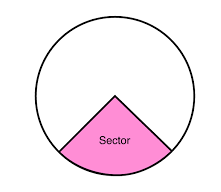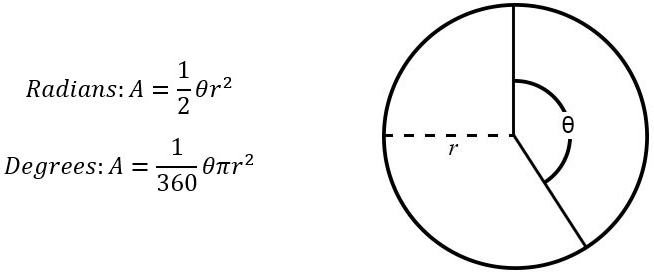
Area of Sector
The Area of a Sector is the area of the pie-shaped portion of any circular shape we often encounter in day-to-day life. The concept of the sector and the calculation of its area have significant applications in mathematics, science, and engineering.
In this article, we will let you know about the sectors of a circle and the different ways to determine their area to help you understand and apply the concept comprehensively.What is a Sector?
The sector of a circle is the portion of a circle formed by a part of the circumference (also known as an arc) and the two radii of the circle that touch the circle circumference at the two ends of the arc. So, it is an area enclosed by an arc and two radii originating from the circle's center. The angle between the two radii determines the size of the sector.
Types of Sectors - Minor and Major Sectors
The two radii in the circle always form two sectors, one smaller and the other larger. These are explained below. Minor Sector: It is the smaller sector formed by the two radii when the angle between them is less than 180 degrees. Major Sector: It is the larger sector formed by the two radii where the angle between them is more than 180 degrees. 
Area of Sector of a Circle
The area of a sector is the space occupied by that particular portion or'slice' of the circle within the total boundary of the circle. It is observed that the area of a sector depends on the angle created by the two radii at the center of the circle. The size of the area increases with the increase in this angle. It means the area of a sector is directly proportional to the angle formed at the center of the circle.Area of a Sector Formula
The formula for sector area is based on the ratio of the angle formed at the center to the total angle. There can be two formulas for the sector of a circle, as mentioned below.When the Angle is in Degrees
When θ is the angle at the center given in degrees and r is the radius of the circle, then the Area of sector = (θ/360) × πr 2When the Angle is in Radians
When θ is the angle at the center given in radians and r is the radius of the circle, then the Area of the sector = (θ/2π) × πr 2 = ½θ x r 2
Area of Sector Formula Derivation
The area of the sector of a circle is derived using the following two concepts:- The area of a circle is πr 2 where r is the circle's radius.
- The angle at the circle's center, which encompasses the entire area, is 360 degrees.
Steps to Find Area of Sector Using Arc Length
The area of the sector of a circle can be determined without knowing the angle formed at the center. In that case, we require the length of the arc corresponding to that sector for calculation purposes. If the length of the arc is given as l and the radius of the circle is r, we can derive the formula for the sector as follows: According to the radian definition, the angle at the center of the circle corresponding to a sector is the ratio of arc length to the radius of the circle. So in this case, if θ is the angle in radians, then θ = l/r So, the area of sector A = ½θ x r 2 = ½ (l/r) x r 2 = (l x r) /2Area of Sector Solved Examples
1. Find the area of a sector with a 7 cm radius and a central angle of 60°.
Solution:
r = 7 cm, θ = 60° Using the formula of area of sector = θ/360× π r 2 , we get, Area = 60/360 x 22/7 x (7) 2 = 1/6 x 22 x 7 = 25.67 square cm.2. Find the area of a sector with a 4 cm radius and a central angle of π/4 radians.
Solution:
r = 3 cm, θ = π/4 So, the area of the sector = ½ x (4) 2 x π/4 = (16/2) x π/4 = 2π = 6.28 square cm.3. Find the areas of minor and major sectors formed by an angle of 120 degrees in a circle of radius 5 cm.
Solution:
The angle made by the sector is θ = 120°. It is a minor sector So, the area of the minor sector = (120°/360°) × (22/7) × 5 2 = 1/3 × 22/7 × 25 = 26.17 square cm. The angle for the major sector is 360°- 120° = 240° So, the area of the major sector = (240°/360°) × (22/7) × 5 2 = 2/3 × 22/7 × 25 = 52.34 square cm.4. The arc length of a sector is 10 cm, and the radius of the circle is 6 cm. Find the area of the sector.
Solution:
The arc length l = 10 and radius r = 6 Using the formula for the area of sector A = (l x r) /2, we get, Area of sector = (10 x 6)/2 = 30 square cm. The sector of a circle is an interesting mathematical concept that has various practical applications. An understanding of the area of a sector for any circular shape gives a clear idea of how much portion of the total circle you are taking into consideration and how it is related to the angle created at the center of the circle. Join Online Mental Maths Class for Kids !!| Related Articles | |
| Corresponding Angles | Isosceles Triangle |
| Average Speed Formula | Differentiation |
| Ratio | Surface Area of Cylinder |
Area of Sector FAQs
When do the areas of minor and major sectors become equal?
Ans. The areas of the minor and major sectors become equal when the angle formed at the center of the circle by two radii is 180 degrees.
What is a very common practical example of a sector of a circle?
A very common practical example of the sector of a circle is the slice of a pizza.
Can a circle have more than one sector?
A circle can have more than one sector formed by different radii.
How many sectors can be formed with an angle of 30 degrees formed by the radii at the center of a circle?
There will be 12 equally-sized sectors formed by different radii with an angle of 30 degrees between two consecutive radii.
If a circle has 8 sectors of equal area, what will be the central angle for each of them?
The central angle for each of these equal 8 sectors will be 45 degrees since all of them add up to 360 degrees.
Talk to a counsellorHave doubts? Our support team will be happy to assist you!

Free Learning Resources
PW Books
Notes (Class 10-12)
PW Study Materials
Notes (Class 6-9)
Ncert Solutions
Govt Exams
Class 6th to 12th Online Courses
Govt Job Exams Courses
UPSC Coaching
Defence Exam Coaching
Gate Exam Coaching
Other Exams
Know about Physics Wallah
Physics Wallah is an Indian edtech platform that provides accessible & comprehensive learning experiences to students from Class 6th to postgraduate level. We also provide extensive NCERT solutions, sample paper, NEET, JEE Mains, BITSAT previous year papers & more such resources to students. Physics Wallah also caters to over 3.5 million registered students and over 78 lakh+ Youtube subscribers with 4.8 rating on its app.
We Stand Out because
We provide students with intensive courses with India’s qualified & experienced faculties & mentors. PW strives to make the learning experience comprehensive and accessible for students of all sections of society. We believe in empowering every single student who couldn't dream of a good career in engineering and medical field earlier.
Our Key Focus Areas
Physics Wallah's main focus is to make the learning experience as economical as possible for all students. With our affordable courses like Lakshya, Udaan and Arjuna and many others, we have been able to provide a platform for lakhs of aspirants. From providing Chemistry, Maths, Physics formula to giving e-books of eminent authors like RD Sharma, RS Aggarwal and Lakhmir Singh, PW focuses on every single student's need for preparation.
What Makes Us Different
Physics Wallah strives to develop a comprehensive pedagogical structure for students, where they get a state-of-the-art learning experience with study material and resources. Apart from catering students preparing for JEE Mains and NEET, PW also provides study material for each state board like Uttar Pradesh, Bihar, and others
Copyright © 2025 Physicswallah Limited All rights reserved.
Get App








